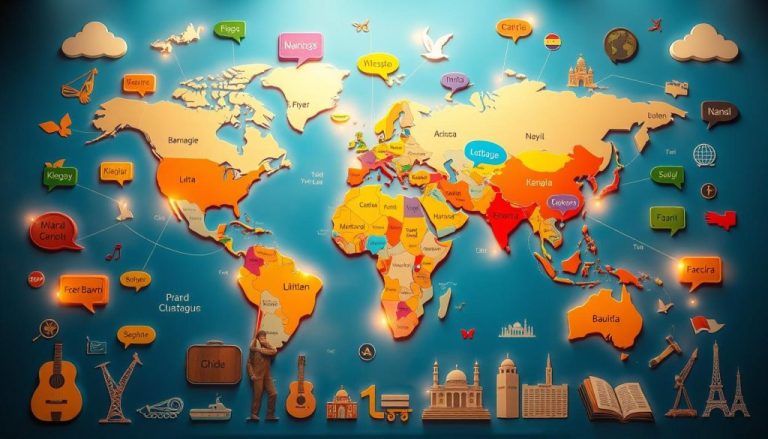Internationalization of Higher Education: 5 Key Insights
Internationalization of Higher Education: In today’s fast-changing world, making higher education global is key for universities everywhere. Students and teachers want to learn from different cultures. This makes cross-border partnerships and exchange programs very valuable.
Internationalization of Higher Education brings many benefits. It improves learning quality and helps students develop global skills. It also builds lasting connections. By embracing global education, schools can attract the best students from all over. They become places where different cultures meet and learn from each other.

Key Takeaways
- Internationalizing higher education helps universities stay ahead in a global market.
- Programs and partnerships that bring cultures together make learning richer. They prepare students for today’s jobs.
- Using technology can make international education reach more people. It opens up chances for online learning and teamwork.
- New educational centers around the world are changing the face of higher education. They offer both challenges and chances for growth.
- To succeed in internationalizing education, schools need a clear plan. This plan should focus on quality, student and teacher mobility, and lasting partnerships.
Current Landscape of Global Higher Education
The world of higher education has changed a lot in recent years. Now, universities everywhere see the value in teaching students from different cultures. They also want to help students and teachers move around the world.
Evolution of Cross-Cultural Education
International education is no longer just for the rich. Today, learning from different cultures is a big part of school. Universities are working hard to bring students and teachers together from all over. They also offer online classes that let people learn from anywhere.
Impact of Technology on Global Learning
Online learning has changed how we learn globally. Students can now work with others from different countries, join online exchanges, and find lots of educational resources online. This has made it easier for schools to teach without borders. It’s helping us understand and share knowledge across cultures.
Emerging Educational Hubs Worldwide
New places are becoming centers for learning all over the world.
- Cities like Singapore, Shanghai, and Dubai are becoming major places for learning,
- they attract top universities and students from all over.
These places help with global mobility and international collaborations. They are shaping the future of education globally.
| Emerging Educational Hubs | Key Characteristics |
|---|---|
| Singapore | – Highly internationalized student population – Collaborative partnerships with leading universities worldwide – Strong focus on cross-cultural education and online education |
| Shanghai | – Rapidly growing number of international students – Increasing number of global mobility programs and international collaborations – Emphasis on innovative and technology-driven learning |
| Dubai | – Diverse international student community – Expansion of online education and virtual learning opportunities – Emergence of specialized cross-cultural education programs |

Challenges and Opportunities in Internationalization of Higher Education
Internationalizing higher education comes with big challenges and great opportunities. One major challenge is making sure campuses are welcoming to everyone. This means supporting students and faculty from different backgrounds.
Changing the curriculum to fit global needs is also tough. Schools must design programs that work well in many cultures.
Another hurdle is breaking down language barriers. Good communication is key for working with people from other countries. Getting enough money for international projects is hard, too. Schools compete for funds to support global partnerships and student exchanges.
The fear of brain drain is real. Top students and teachers might leave for other countries, taking their talents with them. Keeping quality high in international programs is another challenge. Schools must ensure their standards are met everywhere.
But there are also big benefits to internationalizing education. Schools can become more diverse and inclusive, preparing students for a global world. Working with other schools around the world can lead to new research and learning ideas.
| Challenges | Opportunities |
|---|---|
| Diversity and inclusion Curriculum internationalization Language barriers Funding constraints Brain drain Quality assurance | Embracing global perspectives Cultivating a rich, inclusive learning environment Preparing students for an interconnected world Forging international academic partnerships Collaborative research and sharing of best practices |
“Internationalizing higher education is not just about attracting international students; it’s about creating a genuinely global learning experience for all.”
By tackling the challenges and grabbing the opportunities, schools can use internationalization to innovate and exchange cultures. This helps students get ready for the 21st century.
Internationalization of Higher Education:
Strategic Framework for International Academic Partnerships
In today’s global higher education world, strong international academic partnerships are key. This framework shows how to build lasting collaborations, ensure quality in programs, and move students and faculty across borders.
Building Sustainable Cross-Border Collaborations
Creating lasting partnerships needs a thoughtful plan. It’s about understanding each other, sharing goals, and keeping in touch. Good partnerships involve:
- Aligning goals and values
- Building trust and being open
- Knowing who does what
- Working together on research and studies
- Exchanging students and teachers
Quality Assurance in International Programs
It’s vital to keep international programs high-quality and engaging. A strong quality assurance system includes:
- Matching curriculum with global standards
- Setting up joint quality checks
- Assessing students and listening to their feedback
- Helping teachers improve in international settings
- Keeping programs up to date and accredited
Student and Faculty Mobility Programs
Moving students and teachers between schools is a key part of good partnerships. Good mobility programs have:
- Easy credit transfer and recognition
- Help for international students and teachers
- Options for joint degrees
- Money for student and teacher exchanges
- Using alumni to support partnerships
By following this framework, schools can build strong international partnerships, academic collaboration, and curriculum globalization. They can also improve student recruitment and faculty development worldwide.
Conclusion
The world of higher education is changing fast. This change is due to the internationalization of universities. It has brought new ways of learning and teaching across cultures.
Universities that focus on intercultural competence will do well. They also need to get international accreditation and work on international research collaboration. This ensures their programs stay relevant and high-quality.
The future of global higher education looks bright. Universities are working to bring people together and create diverse learning spaces. This effort will help us build a more connected and understanding world.
By embracing internationalization, universities can lead the way in innovation. They will prepare students to face the challenges and opportunities of our changing world.
FAQ
What are the key benefits of internationalization in higher education?
Internationalization of Higher Education brings many benefits. It exposes students and faculty to different cultures and views. It also opens doors for global mobility and helps develop important skills for today’s world.
What are the main challenges facing universities in their internationalization efforts?
Universities face several challenges in internationalizing. They must overcome language barriers and adapt curricula for global students. Funding for international projects is also a concern.
Universities must address brain drain and ensure quality across borders. They also need to navigate complex rules and cultural differences in partnerships.
How can universities build sustainable cross-border collaborations?
Building lasting partnerships is key. Universities should carefully choose partners and align goals. They need to establish clear communication and invest in joint projects.
Regular checks and adjustments are vital to keep partnerships strong.
What is the role of technology in enhancing global learning opportunities?
Technology has changed international education. It makes online collaborations and virtual exchanges possible. This opens up global learning to more people.
It fosters cultural exchange and offers flexible learning options. The right technology can greatly improve Internationalization of Higher Education.
How can universities ensure quality assurance in their international programs?
Ensuring quality in international programs is essential. Universities must align curricula and teaching methods. They should also invest in faculty development and follow international standards.
Regular reviews, student feedback, and benchmarking help maintain quality. This ensures international programs meet high standards.(Internationalization of Higher Education)







